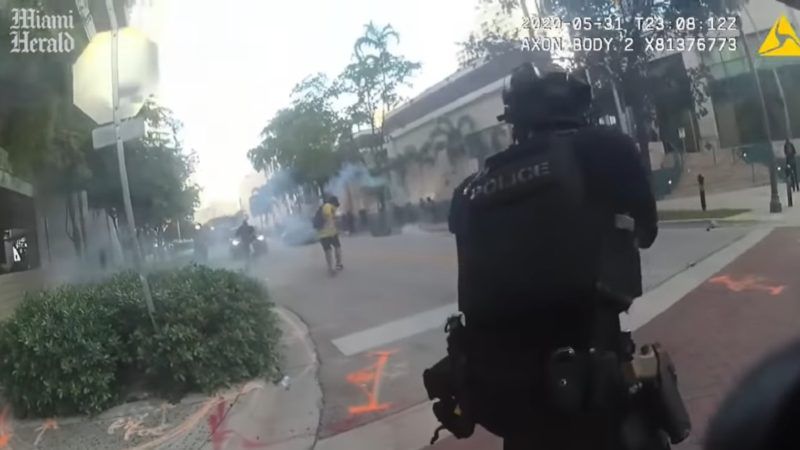Body Camera Footage Shows Florida Cops Laughing About Using Rubber Bullets on Anti-Police Brutality Protesters
Scenes from anti-brutality protests are renewing the debate around the controversial use of rubber bullets.

A Florida police department is investigating officers who joked on camera about the protesters they shot with rubber bullets.
Body-worn camera footage obtained by the Miami Herald shows officers with the Fort Lauderdale Police Department (FLPD) shooting rubber bullets towards protesters during an anti-brutality protest on May 31 and then making jokes.
One officer is heard shouting, "Beat it, little fucker," to a protester who appears to be hit after picking up a tear gas canister and throwing it back in the direction of police. At one point, another officer asks if the body-worn camera is on and then laughs that he "plugged his ass three fucking times."
In a statement released this week, FLPD Chief Rick Maglione says that a longer video "clearly demonstrates our officers were under attack by a group of people who chose to use violence instead of peace to antagonize the situation." Maglione also says the officers were "dealing with the chaos of a developing situation."
FLPD has been criticized for its conduct during the May 31 protest. The department said it was fending off violent agitators in a city garage, but video and photos from the protest do not appear to back this version of events. The protesters appear to have remained peaceful until an officer was seen shoving a kneeling protester. Another police officer quickly stepped in to reprimand him and protesters began to throw water bottles in his direction. The situation escalated when more officers arrived on the scene. One protester was hit with a rubber bullet and suffered a fractured eye socket.
Like the protest in Fort Lauderdale, scenes of aggressive policing tactics at recent anti-brutality protests have renewed the debate around the use of rubber bullets.
The moniker itself is a bit misleading. These large, palm-sized munitions can contain metal cores and are covered by rubber, plastic, and other materials. And while "rubber bullet" suggests a softer impact, which is certainly the case when compared to a live round, this kinetic impact projectile can still cause penetrative injury.
When freelance photographer Linda Tirado described her experience of being shot in the eye with what she believed to be a rubber bullet at a Minneapolis protest, she said, "I was aiming my next shot, put my camera down for a second, and then my face exploded." Protesters carried Tirado away from the scene. Following surgery, a doctor informed her that her vision was not likely to recover.
An American Civil Liberties Union fact sheet breaks down the risks by body part. This includes potential blindness or brain injury if shot in the eye, bleeding if shot in the abdominal region, and lacerations, though the rounds aren't marketed as intended to break the skin. While described by law enforcement as "non-lethal" or "less than lethal," documentation on social media proves these rounds can cause gruesome injuries.
In an article debunking myths about rubber bullets, Inverse found that about 15 percent of injuries caused by the projectile resulted in permanent damage, especially when a person is struck in the head or neck.
Manufacturers advise that these projectiles should only be used for the lower extremities. Some departments, like the Minneapolis Police Department, mandate in their policies that "large muscle groups in the lower extremities including the buttocks, thigh, knees" should be the intended target for 40mm less-lethal rounds. The MPD even notes that targeting other areas such as the "head, neck, spinal cord, groin and kidneys" can cause "injury that can lead to a permanent physical or mental incapacity or possible death."
The FLPD body camera footage and the documented damage from these projectiles around the U.S. demonstrate that law enforcement agencies need to find safer alternatives for crowd control.


Show Comments (105)